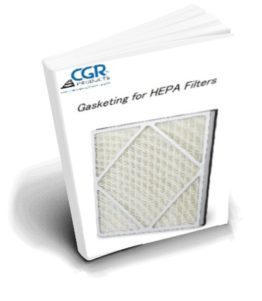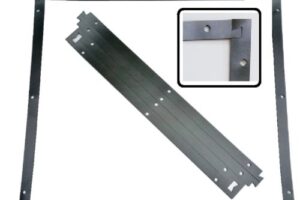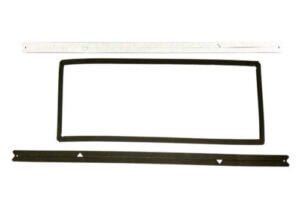Clean air is an important aspect of everyday life. Indoor air is much more contaminated than outdoor air, even with toxic fumes from factories, automobiles, and other types of machines. Natural processes such as carbon dioxide being consumed by plants, constantly moving air, electric thunderstorms, ultraviolet rays from the sun, etc., help to keep outdoor air clean. The air indoors in well insulated structures has nowhere to go. Not only nowhere to go, but can often be filled with dangerous contaminants, germs, and allergens.
HEPA, or High Efficiency Particular Air filters, are high performing filtration devices that can remove airborne particles with a minimum collection efficiency of 99.97 percent for 0.3 microns. Certifications for HEPA filters were established in 1983, but the first development was much earlier. These types of filters date back to WWII during the development of the atomic bomb, also known as the Manhattan Project.
Today most HEPA filters consist of interlaced polyester, polypropylene, or fiberglass fibers that are twisted and turned in many directions to create a web. As particles pass through this web, they are taken out of circulation.
HEPA filters are widely used in lab and factory settings. Other typical applications are consumer products, including cars, vacuum cleaners, and air purifiers
For a FREE downloadable PDF version to keep for your records:
Download the full version of: Gasketing for HEPA Filters here
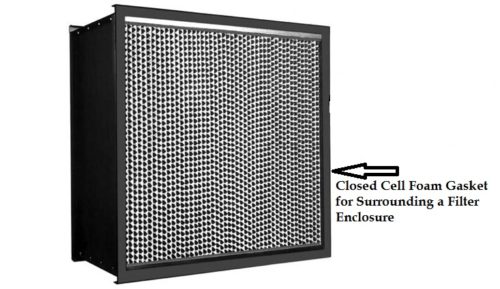
HEPA air filters must be installed so that even the smallest volume of air or gas does not escape the filtration. Therefore, gaskets are a common method used for sealing filter units to their mounting frames. Die cut urethane rubber and closed cell sponge rubber products are more economical and simpler to install than liquid silicone systems. Die cut gaskets play a critical role in the satisfactory operation of HEPA air filters. The most widely used sealing method is a flexible die cut gasket attached to the outer perimeter of the filter frame and pressed against the flat surface of the mounting framework. Gasket materials typically are oil and ozone resistant.
Oil resistant HEPA filter applications will require a gasket material that is rated accordingly. Closed cell sponge rubber made from synthetic rubber (CR- Chloroprene) that conforms to ASTMD1056 2C3 and 2C4 are used throughout the industry. The gasket material must be free of any mold release that was used to manufacture the raw stock. Therefore, splitting or skiving the top layer off is required to make sure the mold release is not present. The gasket then may be die cut to its final shape.
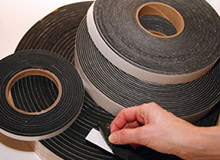
Typical shapes used for HEPA air filter gaskets are strip gaskets, one piece die cuts, or other types of interlocking designs. Interlocking designs are very cost effective and easy to install over typical window frame gaskets.
In instances of very large enclosures, high volumes, or where the design does not allow for strip gaskets, a fold-out or dovetail interlocking gasket may be an option. The fold-out gasket allows the die cut to be expanded to its final shape, eliminating the center scrap. A dovetail gasket works in a similar fashion, except the corners are mitered and fit together comparable to a jigsaw puzzle. The design of the HEPA filter and the level of protection needed will determine if this type of gasket is suitable.
For a FREE downloadable PDF version to keep for your records:
Download the full version of: Gasketing for HEPA Filters here
To attach the cut gaskets to the frame surface, solvent activated, or pressure sensitive adhesive systems are applied to one side of the gasket sealing surface. Joints in the dovetail area are typically sealed with RTV materials that are compatible with closed cell sponge polymers.
In the case of HEPA filters that require no oil resistance, urethane-based foam products are a good
choice due to their low compression set and temperature resistance. Acrylic based pressure sensitive
adhesives are used to fasten urethane-based gaskets to the HEPA filter framework.
What CGR Products can do for you?
CGR Products can assist in suggesting a material for your HEPA filter gaskets. We have worked with many filter manufacturers over the last 50 years. The full CGR Resource Library and team of experts are available to clients with specifications, cost charts, comparative material information and more. Our design team works with automotive, marine, appliance, plastic molding, power tools, electrical, small engines, and countless other clients. Our in-house tool and die capabilities mean maximum problem solving with minimal lead times, and an extensive inventory of raw materials supports projects of all kinds. Safety stocks are in place with our inventory of raw materials, and consultation with our experienced staff is always available to get you started.
About CGR Products:
CGR Products began in 1963 in Greensboro, NC as Carolina Gasket and Rubber Company. Initially, the company focused on cutting precision gaskets for MRO applications within the booming textile industry but has now evolved into supplying OEM and MRO products to multiple markets and offering an array of converting services. CGR Products cuts, slits, laminates, skives, and molds materials into precision components for the industrial OEM market. Operators use more than 100 pieces of quality equipment to efficiently handle jobs with precision. The company’s manufacturing capabilities increased in 1990 with the purchase of Valley Products in Decatur, Alabama, and again in 2012 with the purchase of EG Gasket in Waukesha, Wisconsin. CGR now operates in North Carolina, Alabama, and Wisconsin with 125 employees and over 190,000 square feet of manufacturing, office, and warehouse space.
For a FREE downloadable PDF version to keep for your records:
Download the full version of: Gasketing for HEPA Filters here
